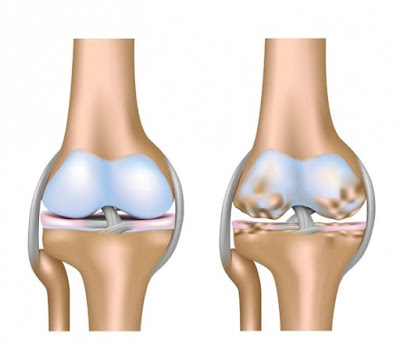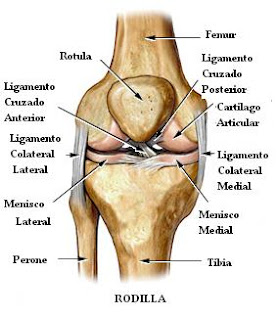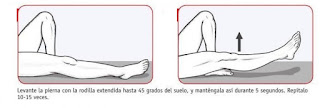WHAT IS IT?
Osteoarthritis, or wear of the knee joint, is a painful,
non-inflammatory, irreversible degenerative disease of the knee joint caused by
wear of the articular cartilage.
Osteoarthritis of the lower limb is a common condition that
affects the elderly, approximately 20% of people over 60 years of age worldwide
experience knee pain. It represents 80% - 90% of hip and knee replacements in
the United States and the United Kingdom.
KNEE ANATOMY
The knee is formed by the union of 2 important bones, the
femur in its distal portion, and the tibia in the proximal portion. It also has
a small bone, called the patella, which articulates with the anterior and
inferior portion of the femur. It can mainly perform flexion and extension
movements. It is surrounded by an articular capsule and several ligaments that
give it stability. In its vicinity, powerful muscles are inserted that make
limb movement possible.
It is composed of the joint action of the femur, tibia,
patella and two fibrocartilaginous discs that are the meniscus. Femur and tibia
make up the main body of the joint, while the patella acts as a pulley and
serves as an insertion to the quadriceps muscle tendon and the patelar tendon
whose function is to transmit the force generated when the quadriceps is
contracted.
PROTHESIS
A knee prosthesis is a mechanical element composed of
various metal and plastic components that replace the knee joint consisting of
tibia, femur and kneecap.
Should I wear a prosthesis? No, we must understand that
osteoarthritis is a degeneration of the joint due to its use. Over the years,
all people have osteoarthritis to a greater or lesser extent. Osteoarthritis is
NOT an indication of putting on a prosthesis, the indication of putting on the
prosthesis is given by pain and / or the functional limitation produced by this
osteoarthritis.
CAUSES
The main causes of osteoarthritis of the knee are:
Trauma during sports and recreational activities, hard
physical work overload, congenital joint deformity, metabolic disorders,
overweight.
TREATMENT
The guideline for the treatment of osteoarthritis is
exercise as a non-pharmacological therapy. Exercise improves the symptoms and
general well-being of people with this pathology, while they are relatively
safe as compared to pharmacological treatments. The improvement of pain and
functional results after treatment with osteoarthritis exercises are
demonstrated by numerous studies.
Great benefits, regarding pain and function, were observed
in people with osteoarthritis of the knee who exercised. The effectiveness of
the exercise was generally greater at 2 months after starting the exercise,
according to the results of the studies.
For the treatment of osteoarthritis pain we also use
radiofrequency, deep heat that helps relieve nerve endings and relax symptoms.
MAIN FACTORS
- The age of who suffers from this deficiency affects,
trials with younger participants demonstrated a more appreciable functional
improvement than older patients after exercise treatment. In the older
population, other age-related conditions (eg, reduced functions in the
cardiovascular and musculoskeletal systems) may also explain the observed
effect.
- Osteoarthritis severity: in general, the results support
the inverse association between benefits of exercise and the severity of
osteoarthritis of the knee (that is, it is believed that the exercise produces
a greater improvement with a milder knee osteoarthritis than more severe).
Patients on the waiting list for surgery, who have knee osteoarthritis in the
most advanced stage of the clinical spectrum, showed a smaller exercise
response compared to those who were not on a waiting list.
EXERCISE PROGRAM
We will perform the exercises 3 sets of 10 repetitions each,
3 times / week.
Exercise 1:
Lying on your back with your leg straight and a towel under
your knee, perform quadriceps contractions by crushing the towel with a hollow
of your knee. Bring the toe towards us to feel more muscle contraction.
Exercise 2:
Lying on your back with your leg straight, raise it straight
until you reach about 45 degrees from the ground, bringing the tip of the foot
up and down again, relaxing the tip of the foot.
Exercise 3:
Lying on your side with your hips and knees bent, separate
your knees from each other but not your feet Being able to increase the
resistance by placing an elastic band between the knees. We want to focus on
strengthening the buttocks.
Exercise 4:
Sitting on a high surface, make knee extensions bringing the
tip of the foot towards us at the end of the movement and withstand that
tension for 5 seconds.
Exercise 5:
Standing with one leg elevated and the support leg slightly
bent, balance for 20-30 seconds and rest for a few seconds. If it seems easy
you can increase the difficulty by making circles with the leg that is in the
air, closing your eyes, using unstable surfaces ...









No comments:
Post a Comment